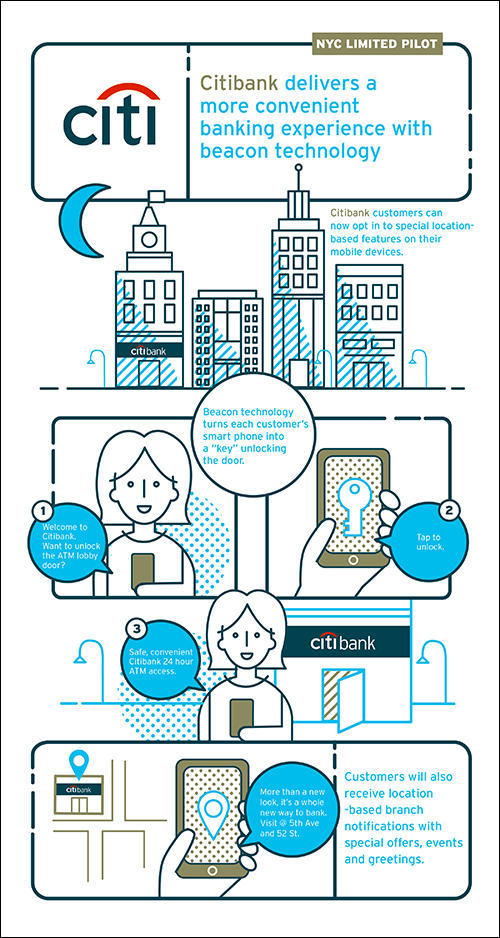Citibank, the retail banking arm of financial services company Citi, is looking to beacon technology to enable new interactions with customers inside and near banking branches, according to Michael Anzola, Citi’s VP of mobile product management. Citibank launched a pilot program in New York City in which beacons trigger messages to its customers’ smartphones, enabling them to use their phones to unlock secured ATM lobby doors, rather than having to unlock the doors via their ATM cards. Citi is working exclusively with beacon manufacturer Gimbal on the pilot, which launched in March 2016.
Citibank is installing 300 Gimbal beacons at 10 Manhattan branches—most of them located in Midtown. Thus far, roughly half of the beacons have been installed. There are 450,000 Citibank customers from New York, New Jersey and Connecticut who are eligible to participate in the pilot, though eligible customers must download the Citi mobile app and opt in to receive location-based notices in the app, in order to use the beacon-based features.
The pilot is evaluating two main use cases, Anzola says, both of which work only with Apple phones and watches at this time. One use case is serving contextual messages, via the Citi app, directly to customers while they are inside a branch location. Using the beacons, Citi can continually determine a customer’s location, by comparing the strength of the RF signal that the phone receives from beacons inside the bank. Citi’s cloud-based server receives this data and also measures the dwell time—how long the customer has remained in the bank—to determine whether to push a notification. Anzola says the notifications are meant to either alert a customer to a special offer, or to reduce his or her wait time. “The messaging is always contextually relevant,” he states.
For example, if a customer using the app is waiting in line for an unusually long time, he or she might receive a notification about services, such as currency exchange, that can be accomplished without having to wait in the main teller queue. Conversely, if the user has a Citigold account, which provides special financial services, the app might push a notice when that customer is at a banking location with a dedicated Citigold service desk.
The other use case, enabling customers to unlock the door to a secure ATM lobby, relies on a beacon installed at the lobby entrance that is tuned to detect a user’s phone when he or she is standing within 1 or 2 feet of the door, explains Brian Dunphy, Gimbal’s senior VP of business development and strategic partnership. Once the phone receives the beacon’s ping, it prompts the user to unlock the door by tapping on his or her phone screen or (if applicable) Apple Watch. The hope is that by not having to dig out an ATM card and place it into the magnetic stripe reader near the door, the customer will be able to access the ATM more quickly and smoothly, thereby reducing the risk of that individual’s wallet or card being stolen.
All 300 beacons being deployed for this pilot—which does not yet have an end date—are Gimbal’s Proximity Series 21 models. Citi is deploying them to transmit a unique, encrypted ID number each time they ping a signal, a feature designed to thwart third parties from spoofing the beacons. Citi is employing Gimbal’s software development kit to enable it to estimate users’ locations within the banks, as well as dwell times.
Additionally, Citi is conducting other pilots to test the use of iris scanning for authenticating banking customers at ATM machines, and voice recognition software that does the same for phone-based transactions.


